Write Down the Relations, that's all!
As usable for a first try, take ideal opamps, that means they have a infinite input resistance, zero output resistance, infinite gain and infinite bandwidth --> ideal opamp.
Start by writing down the behaviour of an capacitor, which you will need later:
0$$i_C = \cfrac{du_c}{dt}\, , $$
let's you easily find the proper equation. Using an ideal opamp, the current in the loop keeps the same, no matter if it is a resistor or a capacitor.
All opamps are used in an inverting mode: inverting integrator and inverting amplifier.
Hence, the 3 equations necessary to solve the problem are:
$$\cfrac{v_1}{1M} = - 1\mu F \cdot \cfrac{d v_2}{dt} \qquad(1),\\
\cfrac{v_2}{1M} = - 1\mu F \cdot \cfrac{d v_3}{dt} \qquad(2),\\
\cfrac{v_1}{90k} = - \cfrac{v_3}{10k} \qquad (3) .$$
Solving these equations for v_3, with 1Mohm * 1uF = 1s, yields:
$$\cfrac{d^{2}v_3}{dt^2} = - 9 \cdot v_3 \, \quad (4) . $$
Using the harmonic ansatz
$$v_3 = e^{j\cdot \omega_0 \cdot t}$$
and use it in (4), leds to
$$v_3 \cdot \omega_0^2 = 9 \cdot v_3 \, \\
\omega_0 = 3\, .$$
Hence, the solution is (ignoring transient behaviour)
$$v_3 = A \cdot \sin (3\cdot t + \varphi_0) \, \quad(5) ,$$
where A and phi_0 are got by solving the unharmonic differential equation (initial condition is V_c = 6V).
At t=0, the output voltage v_3 = 0, therefore
$$ \varphi_0 = 0 \, .$$
Further differentiating v_3 (which is equal v_2) results in
$$ v_2 = - \cfrac{dv_3}{dt} = - 3 \cdot A \cdot \sin (3\cdot t)\, .$$
Since the output of integrator 1 (v_2) at t=0 is -6V (intitial condition), you have
$$ -6\, V = -3 \cdot A \, ,\\
A = 2 \, .$$
Hence the result is:
$$\bbox[5px,border:2px solid red]{
v_3 = 2 \cdot \sin (3\cdot t) \, \qquad(6) .}$$
Hence, as strange as it is, the frequency of the oscillator can be set by the gain of the inverting amplifier.
